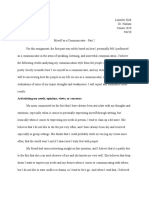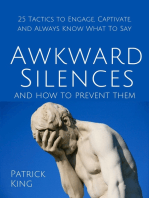0 ratings0% found this document useful (0 votes)
27 viewsSion Mark Andrew - Essay 2
Sion Mark Andrew - Essay 2
Uploaded by
Andrew SionBody language and gestures are an important part of communication but can be interpreted differently depending on cultural and gender norms. The author discusses several experiences where gestures acceptable within their friend group were misunderstood in other contexts, such as hugging opposite-gender friends or maintaining eye contact while speaking. The author also recalls misinterpreting a classmate's serious facial expressions and handshakes as threatening until learning they reflected his own cultural background. The document stresses considering how actions may be perceived based on these factors to effectively convey messages without causing unintentional offense or misunderstandings.
Copyright:
© All Rights Reserved
Available Formats
Download as DOCX, PDF, TXT or read online from Scribd
Sion Mark Andrew - Essay 2
Sion Mark Andrew - Essay 2
Uploaded by
Andrew Sion0 ratings0% found this document useful (0 votes)
27 views3 pagesBody language and gestures are an important part of communication but can be interpreted differently depending on cultural and gender norms. The author discusses several experiences where gestures acceptable within their friend group were misunderstood in other contexts, such as hugging opposite-gender friends or maintaining eye contact while speaking. The author also recalls misinterpreting a classmate's serious facial expressions and handshakes as threatening until learning they reflected his own cultural background. The document stresses considering how actions may be perceived based on these factors to effectively convey messages without causing unintentional offense or misunderstandings.
Original Title
SION MARK ANDREW_ESSAY 2
Copyright
© © All Rights Reserved
Available Formats
DOCX, PDF, TXT or read online from Scribd
Share this document
Did you find this document useful?
Is this content inappropriate?
Body language and gestures are an important part of communication but can be interpreted differently depending on cultural and gender norms. The author discusses several experiences where gestures acceptable within their friend group were misunderstood in other contexts, such as hugging opposite-gender friends or maintaining eye contact while speaking. The author also recalls misinterpreting a classmate's serious facial expressions and handshakes as threatening until learning they reflected his own cultural background. The document stresses considering how actions may be perceived based on these factors to effectively convey messages without causing unintentional offense or misunderstandings.
Copyright:
© All Rights Reserved
Available Formats
Download as DOCX, PDF, TXT or read online from Scribd
Download as docx, pdf, or txt
0 ratings0% found this document useful (0 votes)
27 views3 pagesSion Mark Andrew - Essay 2
Sion Mark Andrew - Essay 2
Uploaded by
Andrew SionBody language and gestures are an important part of communication but can be interpreted differently depending on cultural and gender norms. The author discusses several experiences where gestures acceptable within their friend group were misunderstood in other contexts, such as hugging opposite-gender friends or maintaining eye contact while speaking. The author also recalls misinterpreting a classmate's serious facial expressions and handshakes as threatening until learning they reflected his own cultural background. The document stresses considering how actions may be perceived based on these factors to effectively convey messages without causing unintentional offense or misunderstandings.
Copyright:
© All Rights Reserved
Available Formats
Download as DOCX, PDF, TXT or read online from Scribd
Download as docx, pdf, or txt
You are on page 1of 3
Sion, Mark Andrew February 18, 2021
BSCHE 1
BODY LANGUAGE: FOR BETTER OR FOR WORSE?
Communication is very important for us human beings. It allows us to connect to other
people. It also helps us to send and receive the information we need in our everyday life. When
we talk about communication, it doesn’t just mean talking and listening. It is also comprised of
what we call body language or gestures. Indeed, words aren’t enough to express the things we
want to tell to the person we are talking to. Sometimes, actions are needed to intensify our
statements further. A person who just plainly stands and talks in front of so many people looks
boring and dull, and sometimes we even wonder if the things he is saying are accurate. Body
language or gestures could be a great aid to help the receiver understand clearly the message we
want to convey. It also helps the speaker to attract and to encourage the listeners to listen to him
or her. But sometimes, these actions could bring more harm than good if we don’t take a look at
the background, especially the culture and some other factors, of the person we are
communicating with. Some actions that we are unknowingly doing, which seem normal to us,
may be perceived as negative by the receiver of our message.
When it comes to gender, we should know that there is a thin line that limits and controls
what men and women can do to each other, and that thin line represents each other’s privacy. I
both have male and female friends. When we are together, it feels like we are the “wildest
people” in the world, and we’ll laugh even at small things that we see. But even though we are so
close, we know our limitations. We, men, can jokingly touch each other’s chests or private parts
just to annoy each other. We even punch each other without crying, or say nasty things without
us getting offended since we know that those things are just normal for us. But when it comes to
our female friends, we don’t grab their chest just to make fun of them or saying nasty things and
dirty jokes to them, especially in public places where many people who will hear it will find it
improper and rude. We also don’t punch our female friends “just for fun” because we respect
them and we all know that will fall under RA 9262 or the Violence Against Women Act.
I still have so many stories regarding the things that are appropriate and inappropriate to
say and do, especially to people opposite of our gender. I remember one time, when I and my
female friend (who is the most sensitive in the group) were in a heated argument, I accidentally
said something bad to her, so I have to calm and stop her from crying for almost 30 minutes. It
took me so many hours before I gained her forgiveness. I also remember my two friends, boy
and a girl, being reprimanded by my teacher for running around the campus, holding hands and
laughing like two crazy people. Our teacher got mad and I remembered her saying, “This is a
place for learning and not for dating.”
Another example is, seeing two boys hugging or two girls hugging in public are just
nothing but a normal scene. It’s just a sign of friendship. But when we see a boy and a girl
hugging, we sometimes misinterpret them and think of them as couples. Even though how much
they’ll deny, most of us will still think they are in a relationship because that’s what the society
has told us to think; a man and a woman can’t be friends. When you see each other being so
close together, they are couples.
Aside from knowing each other’s privacy and limiting ourselves when doing those kinds
of “body languages”, let us also think what other people might think. We may be doing
something friendly and nice, but others may perceive it as being flirtatious and forbidden,
especially for us Filipinos, wherein we live in a country bounded by conservatism.
In terms of ethnical background, I remember this one story. When I was on Senior High
School, I studied in an Adventist School where there are a lot of international students. Diversity
in terms of race, language, and beliefs were clearly seen. We have this classmate from South
Africa. Not to be racist, but at first, we were afraid to talk to him because he always has this
serious face. Every time he will look at us, his eyes looks like he’s about to punch us or want to
fight with us. One time, we had an activity in our Oral Communication subject where everyone is
paired to someone they are not friends with. I was paired with our African classmate and at first,
I find it awkward to talk to him. He initiated the conversation. We asked each other’s names and
I thought he’s going to break my hand when we did a handshake. But he said, it is just normal in
their country, and the tighter the better (since it means you really want to know the person more
and you want to befriend him/her more). Since then, things don’t get awkward with us anymore
and he became a part of our group of friendship. We’ve got to furtherly know him and he is the
exact opposite of our first impression to him.
In terms of cultural background, I have this story that I will never forget. I am a Filipino
and I even have no idea with some of the body languages or gestures that should be avoided in
our country, in which I am unknowingly doing. One time, I was in a relative’s party. Someone
was talking to me and I was seriously listening to her while I am crossing my arms. I was really
interested and I just did that gesture because I find it comfortable when I do that. After a few
minutes, she stopped talking and asked me if I’m uninterested since I was doing that body
language. It was too late for me to realize that that gesture is usually done when you don’t want
to talk to that person or you’re bored with them. I also remember when my teacher reprimanded
me for not giving her a direct eye contact while I was talking. She found it rude and told me to
never do it again since it’s kind of disrespectful to the one you’re talking to.
With these things, I’ve realized that we shouldn’t just think of the things we will say. We
must also take a look of the body languages and gestures we will use for our intentions are
usually shown and reflected into it. With the proper use and execution of these things, we will
surely be able to convey the message we want to tell to our receiver without any disturbances.
We must be always sensitive, and remember that each of us have our own indifferences
especially with our beliefs and culture. What is acceptable to us maybe disrespectful to others.
Let us educate ourselves. When going to a place we are not familiar with, let us make it a habit to
research about the culture of the place and the do’s and don’t’s. Every culture is unique for each
country and places. These indifferences that we possess are what makes us a perfect creation of
God.
You might also like
- Left of BangDocument22 pagesLeft of Bangfirebase556No ratings yet
- Operate in A Culturally Diverse Work Environment 2nd Ed.Document40 pagesOperate in A Culturally Diverse Work Environment 2nd Ed.Kenard96% (26)
- Personal ReflectionDocument2 pagesPersonal Reflectionapi-348448345No ratings yet
- A Translation by Amanda BaggsDocument2 pagesA Translation by Amanda BaggsJavier Ruiz de ArcauteNo ratings yet
- Theory of Business Comm.Document36 pagesTheory of Business Comm.Charming Renu100% (1)
- Break Rapport To Spark AttractionDocument21 pagesBreak Rapport To Spark AttractionDoubleNo ratings yet
- Oral Communication in Context: Quarter 1 - Module 5: Types of Speech ContextDocument19 pagesOral Communication in Context: Quarter 1 - Module 5: Types of Speech ContextRuben100% (4)
- Oral Presentation Rubric For Life Cycle of The ButterflyDocument2 pagesOral Presentation Rubric For Life Cycle of The Butterflyapi-217889949No ratings yet
- Non Verbal CommunicationDocument13 pagesNon Verbal CommunicationSukoon SarangNo ratings yet
- DSM 5 Interview ASD EnglishDocument10 pagesDSM 5 Interview ASD EnglishJacob NotHank FrancisNo ratings yet
- Change ProjectDocument12 pagesChange Projectapi-316613909No ratings yet
- PHILOSOPHY (Intersubjectivity)Document9 pagesPHILOSOPHY (Intersubjectivity)Love LoveNo ratings yet
- Ie0 - W1 - SS7 - Speaking Wheel - People QuestionsDocument18 pagesIe0 - W1 - SS7 - Speaking Wheel - People QuestionsAnn TranNo ratings yet
- Uts PDFDocument4 pagesUts PDFAina Saunar VargasNo ratings yet
- Getting Naked Five Steps To Finding The Love of Your Life (While Fully Clothed & Totally Sober)Document11 pagesGetting Naked Five Steps To Finding The Love of Your Life (While Fully Clothed & Totally Sober)Macmillan Publishers100% (1)
- COM 112 Synthesis Essay Chapter 6 LanguageDocument3 pagesCOM 112 Synthesis Essay Chapter 6 LanguageKatie DavisNo ratings yet
- Unit 1 Lesson 4Document4 pagesUnit 1 Lesson 4Roxanna Mhae Agarin VidamoNo ratings yet
- Online Relationship Essay in REDocument3 pagesOnline Relationship Essay in REGilda Genive AriolaNo ratings yet
- Crommunication Skill JournalDocument8 pagesCrommunication Skill Journalapi-556990568No ratings yet
- Open-Genre Literacy Narrative EssayDocument4 pagesOpen-Genre Literacy Narrative Essaytaybrown1405No ratings yet
- англDocument87 pagesанглanntosshhkkaNo ratings yet
- Agent of Social Change EssayDocument3 pagesAgent of Social Change Essaytori avaricioNo ratings yet
- Describe A Time You Spend With Your Friend in Your ChildhoodDocument5 pagesDescribe A Time You Spend With Your Friend in Your Childhoodsimon pengNo ratings yet
- Berry Humansexuality 1Document5 pagesBerry Humansexuality 1api-662698294No ratings yet
- Myself As A Communicator - Part II Interview Three PeopleDocument7 pagesMyself As A Communicator - Part II Interview Three Peopleapi-536179295No ratings yet
- Talk About It!: 12 Steps to Transformational Conversations...even when you disagreeFrom EverandTalk About It!: 12 Steps to Transformational Conversations...even when you disagreeNo ratings yet
- Week 5 Discussion Question 2Document2 pagesWeek 5 Discussion Question 2Jaed SalazarNo ratings yet
- When Silence FallsDocument2 pagesWhen Silence FallsLeonardo DiazNo ratings yet
- Is There A Difference Between Technology-Based Communication and Communication That Comes From A Human Body (Voice, Gesture, Body Language, Etc.) ?Document15 pagesIs There A Difference Between Technology-Based Communication and Communication That Comes From A Human Body (Voice, Gesture, Body Language, Etc.) ?api-302567105No ratings yet
- The Big Power of Tiny Connections: How Small Interactions Spark Awesome OutcomesFrom EverandThe Big Power of Tiny Connections: How Small Interactions Spark Awesome OutcomesNo ratings yet
- Friendship 1Document4 pagesFriendship 1Cristina BariNo ratings yet
- Life Before Death: Avoid Regret, Strengthen Relationships, Be the Best You Can Be, For Those You LoveFrom EverandLife Before Death: Avoid Regret, Strengthen Relationships, Be the Best You Can Be, For Those You LoveNo ratings yet
- These Are The Scenarios That I've Experienced by Communicating With Diverse PeopleDocument2 pagesThese Are The Scenarios That I've Experienced by Communicating With Diverse PeopleRhod Jayson RicaldeNo ratings yet
- Progression 1 Friendship RevisedDocument5 pagesProgression 1 Friendship Revisedapi-242541407No ratings yet
- Ielts Speaking Topics With Answers PDF Friends 16f4243bafDocument3 pagesIelts Speaking Topics With Answers PDF Friends 16f4243bafdmiiiii.19102005No ratings yet
- Awkward Silences and How to Prevent Them: 25 Tactics to Engage, Captivate, and Always Know What To SayFrom EverandAwkward Silences and How to Prevent Them: 25 Tactics to Engage, Captivate, and Always Know What To SayNo ratings yet
- Reflection PaperDocument5 pagesReflection PaperAmalNo ratings yet
- Midsummer - Manuel ArguillaDocument1 pageMidsummer - Manuel ArguillarizjenbernalNo ratings yet
- How to Become Proficient in Social Interaction: Learning the Art of Small Talk & Overcoming ShynessFrom EverandHow to Become Proficient in Social Interaction: Learning the Art of Small Talk & Overcoming ShynessNo ratings yet
- Speaking - Unit 7Document7 pagesSpeaking - Unit 7Nadia GanjiNo ratings yet
- 2 Week 1-2Document11 pages2 Week 1-2RM RiveraNo ratings yet
- Reaction PaperDocument2 pagesReaction PaperMerysol T. ZalunNo ratings yet
- Intercultural Communication-Unraveling The Other SideDocument4 pagesIntercultural Communication-Unraveling The Other SideYuki SimbaNo ratings yet
- Final EportfolioDocument4 pagesFinal Eportfolioapi-495023869No ratings yet
- During The Next SemesterDocument2 pagesDuring The Next SemesterGroot WiseNo ratings yet
- catch-upfriday-ABM 12Document16 pagescatch-upfriday-ABM 12jeanaguilos2023No ratings yet
- Respecting Your EldersDocument2 pagesRespecting Your EldersRahayu AliasNo ratings yet
- WR2 Essay 1Document4 pagesWR2 Essay 1NeroNo ratings yet
- English 1301 Rough DraftDocument2 pagesEnglish 1301 Rough Draftnesly chevezNo ratings yet
- Revised_Order 3940_Personal NarrativeDocument5 pagesRevised_Order 3940_Personal NarrativelumbasioNo ratings yet
- Body Language and Relationships: Learn the Secret Meaning Behind Every MoveFrom EverandBody Language and Relationships: Learn the Secret Meaning Behind Every MoveRating: 4.5 out of 5 stars4.5/5 (2)
- What Makes A Good FriendDocument11 pagesWhat Makes A Good FriendAndreea MacsimNo ratings yet
- From Darkness to Sunshine: Making Unlimited Friends and ConnectionsFrom EverandFrom Darkness to Sunshine: Making Unlimited Friends and ConnectionsNo ratings yet
- Anne Frank Task 1 and 2Document2 pagesAnne Frank Task 1 and 2khoudiathioune07No ratings yet
- Assalamualaikum Warrahmatullahi WabarrakatuhDocument3 pagesAssalamualaikum Warrahmatullahi Wabarrakatuhppg.dinaanggraini00130No ratings yet
- Body Language How To Analyze People and Use Powerful Communication, Persuasion and Negotiation Skills To Influence People (Navarro, Philip Houston, Joe) (Z-Library)Document95 pagesBody Language How To Analyze People and Use Powerful Communication, Persuasion and Negotiation Skills To Influence People (Navarro, Philip Houston, Joe) (Z-Library)samucas02escolaNo ratings yet
- Why Are You So Sensitive?: Navigating Everyday, Unintended MicroaggressionsFrom EverandWhy Are You So Sensitive?: Navigating Everyday, Unintended MicroaggressionsNo ratings yet
- 10 Moments That Make A FriendshipDocument5 pages10 Moments That Make A Friendshipnatasha sahjwaniNo ratings yet
- Love for Imperfect Things: How to Accept Yourself in a World Striving for PerfectionFrom EverandLove for Imperfect Things: How to Accept Yourself in a World Striving for PerfectionRating: 4 out of 5 stars4/5 (21)
- That's Not What I Meant!: How Conversational Style Makes or Breaks RelationshipsFrom EverandThat's Not What I Meant!: How Conversational Style Makes or Breaks RelationshipsNo ratings yet
- Service To Learning Program Access To Clean Potable Water: I. Slu'S Vmo StatementDocument7 pagesService To Learning Program Access To Clean Potable Water: I. Slu'S Vmo StatementAndrew SionNo ratings yet
- Edoc - CHAP 1 AND PROBLEMS Exp 3Document3 pagesEdoc - CHAP 1 AND PROBLEMS Exp 3Andrew SionNo ratings yet
- 3417 Che 2131L - Experiment 1 - Moriah EdocDocument53 pages3417 Che 2131L - Experiment 1 - Moriah EdocAndrew SionNo ratings yet
- School of Engineering and Architecture Saint Louis University Baguio City, PhilippinesDocument1 pageSchool of Engineering and Architecture Saint Louis University Baguio City, PhilippinesAndrew SionNo ratings yet
- Midterm Quiz #1Document4 pagesMidterm Quiz #1Andrew SionNo ratings yet
- CH-440 NanotechnologyDocument22 pagesCH-440 NanotechnologyAndrew SionNo ratings yet
- DocumentDocument4 pagesDocumentAndrew SionNo ratings yet
- Chapter 2Document11 pagesChapter 2Andrew SionNo ratings yet
- Mark Andrew Sion - Project ProposalDocument2 pagesMark Andrew Sion - Project ProposalAndrew SionNo ratings yet
- Mark Andrew Sion - First AiDocument1 pageMark Andrew Sion - First AiAndrew SionNo ratings yet
- Body Language in The Classroom - Important PDFDocument10 pagesBody Language in The Classroom - Important PDFPRAKNo ratings yet
- CCA Planner 2024-2025Document8 pagesCCA Planner 2024-2025aljinNo ratings yet
- Scenario 5 Good MannersDocument28 pagesScenario 5 Good Mannersmichipr3ndsNo ratings yet
- Communication SkillsDocument103 pagesCommunication Skillsunendrat100% (1)
- Giving PresentationsDocument7 pagesGiving PresentationsTariNo ratings yet
- DLP DramaDocument13 pagesDLP DramaEthel Gillian ColomaNo ratings yet
- Imperialism EssayDocument6 pagesImperialism Essayd3gn731z100% (2)
- PURCOMDocument6 pagesPURCOMsheesahleeNo ratings yet
- Part 2 Business Communication and Corporate Life SkillsDocument72 pagesPart 2 Business Communication and Corporate Life SkillsDEEPAK GROVERNo ratings yet
- Term Paper in CommunicationDocument20 pagesTerm Paper in CommunicationTerrencio ReodavaNo ratings yet
- Business Communication - January 19Document36 pagesBusiness Communication - January 19Chriscel Valiente-PanaliganNo ratings yet
- Reading Girls Mind: Distance Between You and HerDocument4 pagesReading Girls Mind: Distance Between You and HerChintu_90No ratings yet
- Body LANGUAGE ASSIGNMENTDocument24 pagesBody LANGUAGE ASSIGNMENTCAE ANALYSTNo ratings yet
- Assertiveness Skills BasicsDocument84 pagesAssertiveness Skills BasicsCorina NeaguNo ratings yet
- B. COMM Unit-IDocument13 pagesB. COMM Unit-ISatyam AnandNo ratings yet
- Anh Văn 3 4 - (EDITABLE) PBA Manual - Interview ProjectDocument29 pagesAnh Văn 3 4 - (EDITABLE) PBA Manual - Interview Projecttrọng phanNo ratings yet
- Facial Expression and GestureDocument12 pagesFacial Expression and GestureNova SetiajiNo ratings yet
- Exam Tutor Textbook - 25-50Document23 pagesExam Tutor Textbook - 25-50Oleg DemianivNo ratings yet
- Chapter 3 - What Do We RepresentDocument10 pagesChapter 3 - What Do We Representnicolasanceaume1003No ratings yet
- Customer Service With A Heart: The Disney WayDocument34 pagesCustomer Service With A Heart: The Disney WaykannukapoorNo ratings yet
- Bài Giao Thoa Văn Hóa LaiDocument74 pagesBài Giao Thoa Văn Hóa LaiLong NguyễnNo ratings yet
- 025 048 PDFDocument24 pages025 048 PDFjanismoreNo ratings yet



































































































